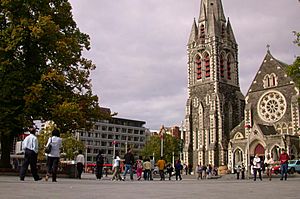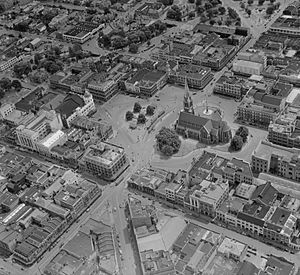Cathedral Square, Christchurch facts for kids
Quick facts for kids Cathedral Square |
|
|---|---|
| Public square | |
| mi: Whiti-reia (Māori) | |
| Nickname(s): The Square | |
 Cathedral Square in 2020 |
|
| Location: | Christchurch, New Zealand |


Cathedral Square, often called the Square, is the very heart of Christchurch, New Zealand. It's where the city's main Anglican church, ChristChurch Cathedral, stands. The Square is meant to be where two main streets, Colombo Street and Worcester Street, cross. However, these streets now go around the Square. The area was badly damaged during the February 2011 Christchurch earthquake.
Contents
How Cathedral Square Got Its Name
The Square was first planned to be called Ridley Square. This name was for a Protestant hero named Nicholas Ridley. But in 1850, when the first map of central Christchurch was made, it was already called Cathedral Square.
Interestingly, two other squares nearby are named after Ridley's friends, Cranmer and Latimer. All three were important figures linked to Oxford, which is why Christchurch has many names connected to that famous university.
The Square's History
When Christchurch was first mapped in 1850, the plan was for Christ's College (a school) and ChristChurch Cathedral to be built right next to each other in Cathedral Square. This idea was inspired by a place called Christ Church in Oxford, England.
However, the space in Cathedral Square wasn't big enough for the college. So, in 1853, it was suggested to move the college to land set aside for the Christchurch Botanic Gardens. A law was passed in 1858 to make this official. This law also said that Colombo Street would go straight through the middle of Cathedral Square. The cathedral would be built to the west of this road.
Most Christian churches face east. This is because people used to believe the east was where mankind first lived. To follow this tradition, Henry Harper, Christchurch's first Bishop, wanted the cathedral to be on the eastern side of the Square. This way, the main entrance would face Colombo Street, and people would pray towards the east. Another law was passed in 1859 to allow this change.
Just before the cathedral's foundations started in 1864, the path of Colombo Street through the Square changed again. It was given a curve to the west. This change made the cathedral's tall tower visible from far away along Colombo Street.
A statue of John Robert Godley, who helped found Christchurch, was put up in the Square on 6 August 1867. It was the first public statue in all of New Zealand! The city's main post office was also built next to the Square in 1879.
Over the years, Cathedral Square has been redesigned many times. In 1965, the road in front of the cathedral was closed. In 1972, the road in front of the Post Office was also closed. This created more space for people to walk. In the late 1990s and early 2000s, the Square got new tiles. Some people didn't like these tiles because they were too shiny when dry and slippery when wet.
In 2001, a large modern sculpture called The Chalice was put in the Square. It looks like an upside-down cone and was made for the new millennium. It was designed by Neil Dawson and has 42 leaf shapes with different plants on them.
Before 2011, the Square was the main meeting spot for people in the city. It was a popular place for street performers and speakers. One very famous speaker was The Wizard of New Zealand.
New plans for the Square were shown in 2017. These plans would remove the roads through the Square and add green spaces and water features. The Square would be split into five different areas. However, these plans have not yet been built because they need more money.
The Te Pae Christchurch Convention Centre opened in 2021. It is one of the city's important new buildings and the third new building in the Square since the earthquakes. The others are Tūranga (the central library) and the Spark building.
In 2022, work began to fix up some "tatty" (untidy) parts of the Square. These plans were supposed to start in 2019 but were delayed. Major work on these areas began in July 2023.
Even though it's called a "square," its actual shape is like a cruciform, which means it's shaped like a cross.
Important Heritage Buildings
Cathedral Square has many buildings and statues that are officially protected as heritage sites by Heritage New Zealand. Many of these were damaged in the February 2011 Christchurch earthquake. Sadly, some were lost because of the earthquake damage.
Here are some of the important heritage places:
- ChristChurch Cathedral is one of the most important heritage buildings.
- The Press Building was badly damaged in the 2011 earthquake and was taken down.
- The former Chief Post Office is another important building.
- The Old Government Building is also a protected heritage site.
- The Citizens' War Memorial is a monument to remember those who served in wars.
- The Godley Statue fell off its base in the 2011 earthquake. Old time capsules were found inside its base!
- The Regent Theatre is a historic theatre building.
- The Lyttelton Times Building was also taken down in 2011.
- The Sevicke Jones Building collapsed during the February 2011 earthquake.
- Warner's Hotel had its historic part taken down.
Transport in the Square
When steam trams started running in Christchurch in 1880, they all left from the Square. Later, when buses replaced trams in 1954, the Square became the main place for buses to start their journeys. For many years, the Square was a very busy road intersection.
In 1962, the road in front of the cathedral was closed to traffic. In 1972, the southwest part of the Square was also closed to traffic. This made more space for people to walk around.
Trams came back in 1995, but this time as a tourist ride around the city centre. Most buses stopped leaving the Square when a new Bus Exchange opened in 2000. After that, only the airport bus, taxis, and shuttles used the Square for transport.
After the February 2011 earthquake, the Square was closed off. It reopened on 30 June 2013, but some areas and buildings stayed fenced off because of earthquake damage.
See also








